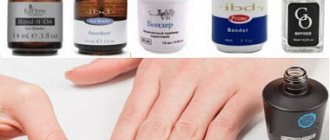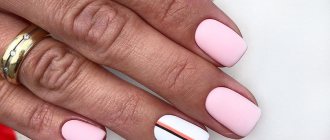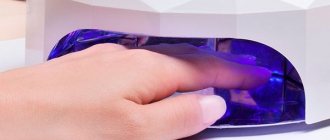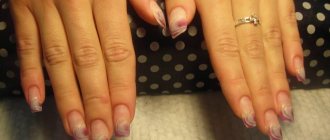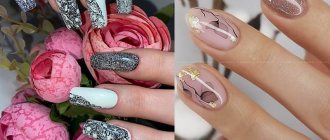Manicure is one of the most popular beauty procedures. To ensure that your nails look beautiful and neat, and that the coating lasts a long time, the master must use proven professional products. One of these products is primer.
A primer is a liquid that degreases the nail and dries it. How well the gel polish “adheses” to the nail plate depends on the quality of the product.
As Anna Ruben, master of manicure and pedicure, founder of the studio and manicure instructor , notes: it is important to choose the right primer for the client, depending on the structure and characteristics of the nails.
There are many types of this product on the Russian market - acidic, acid-free, bonders. We are publishing a rating of the best primers of 2022 with reviews and advice from an expert.
What is a nail primer?
Nail primer is the basis for manicure (nail extension). The liquid is often used to strengthen the natural surface when using acrylic or gel materials. Thanks to the proper use of this liquid, the artificial manicure will last much longer and your nails will remain less deformed.
Nail primer (what it is and how to apply it is described below) is a liquid without fragrance or color. Primers are sold in glass bottles with a brush for ease of application. To ensure greater safety of the product, the bottle is made opaque to protect it from sunlight.
Developing companies do not add flavors or dyes to ensure safety for people with hypersensitivity or allergies. The nail fluid dries out very quickly, which can be seen when a white coating appears after treatment. This means that you can continue to work with extensions.
Why do you need a nail primer?
The primer is widely in demand in professional salons and when doing manicure work yourself.
Depending on the type of work and materials, specialized liquids vary somewhat, but the main tasks for all types are the same:
- guarantees comprehensive protection of the natural nail plate from the appearance of yellow plaque, peeling, and the formation of fungal microflora;
- By avoiding the use of a primer, there is a likely risk of a “greenhouse effect” appearing between the natural and artificial nail plate. This entails the formation of harmful microorganisms under extended nails;
- effective gluing of the extended surface. The durability of the manicure depends on the quality and reliability of the primer;
- functional degreasing of the nail before extensions.
Don't miss the most popular article in the section: How to draw monograms on nails step by step for beginners. Instructions with photos.
What's better
It is difficult to talk about which type of product is better, because in many respects the indicators depend on the basis for which the primer composition is purchased. For acrylic, acidic is the best, since it is the one that will ensure the greatest adhesion of the natural and artificial layers. But at the same time, only masters can use such a product and only in a salon.
Acid-free will be relevant for both salon and home use, but only if used under gel or shellac (you can see the difference between gel polish and shellac here). It is absolutely not suitable for acrylic, as it does not provide the proper bonding effect for this material. It is safer to use and does not have such an aggressive effect on the keratin layer of the plate as the acid version.
Types of nail primer
Today you can buy two main types of primers on the market: acidic and acid-free.
The difference between them is characterized by the final quality of the manicure and appearance:
- A nail primer (what it is and what its purpose is, you can read above) of the acidic variety stimulates the opening of the nail scales, after which it etches the surface of the natural nail, so the artificial surface has better adhesion. This product is very drying to natural nails, so it is best used for oily nails, especially springboard-shaped nails. When using an acid primer, you must be careful to limit its contact with the eyes and mucous membranes. Otherwise, burning and redness will appear.

- The acid-free nail primer works on the principle of “double tape”, thanks to which the natural plate and gel coating have the strongest possible adhesion. The advantage of this liquid is that a special component changes the acidity. This makes the acidity of a natural nail as close as possible to the artificial coating. This is a more gentle product, less dangerous for the skin, but in terms of effectiveness it is used on a par with acidic. The product is best suited for gel extensions. An acid-free primer effectively removes oil from the nail plate, dries it, and prevents fungal infections.
Acid Based Primer
Understanding the difference between an acidic and acid-free primer, it is first worth studying in detail the first and second substances, their composition and properties. Then it will become extremely clear what’s what, and no additional questions should arise. In most cases, acid primers contain a certain substance - methacrylic acid. Recently, a whole wave of protest and indignation has risen around her in the press. Some consider it a powerful carcinogen, others talk about total harm to the human liver, and others even call it a “slow killer.” So which of the above is true and which is outright fiction?

Photo from the site: vchemraznica.ru
- Methacrylic acid is a substance with a third degree of danger out of four, that is, conditionally toxic. It does not have a cumulative effect, that is, it does not accumulate in the body, but is immediately eliminated from it.
- Acid vapors can be really dangerous, especially if you inhale them for quite a long time, so you need to work with primers in respirator masks and gloves, avoiding getting the substance on the dermis of your hands.
- The use of a primer with acid in closed and poorly ventilated areas is not allowed, which is the main difference between an acid primer and an acid-free one.
- Despite the relative danger, if we talk about carcinogens, that is, substances that cause cancer and tumors, then neither at home nor in the salon it is simply impossible to create such a high concentration of a substance that it becomes so dangerous for the human body. He would rather lose consciousness from lack of oxygen and intoxication than begin to produce cancer cells.
- To degrease and remove gloss from nails, it is not pure methacrylic acid that is used, but its diluted version, which is a primer. Its concentration is not so high as to cause irreparable harm, but it can cause quite significant burns to soft tissues and skin, so you will have to be extremely careful when working.
You need to know that the methacrylic acid in question was previously used and quite actively in dental practice, and continues to be used today. But no one is outraged by this fact, which means that it simply cannot bring much harm if the technology is strictly followed.
What is acid primer used for?

Photo from the site: Bestshellac.ru
In addition to acid, the acid primer contains another harmful substance called butyl acetate. Its concentration is very low, as it is caustic and toxic. It also contains ethanol, which is essentially ordinary alcohol; it reliably degreases and disinfects any surfaces. Acid and acid-free primers differ significantly in their scope of application, so let’s figure out what is intended for what.
- An acid primer makes the surface of the nail more porous and rough, which significantly increases its adhesion to the coating.
- It penetrates deep into the nail, softening it, so you need to use such products with extreme caution so as not to spoil your nails.
- The methacrylic acid primer dehydrates and degreases the nails so that the subsequent coating adheres firmly and does not peel off.

Photo from the site: Bestshellac.ru
Another extremely useful factor that an acid primer has is preventing the very possibility of bacterial growth under the coating applied on top. Previously, there were often cases when a banal fungus developed under extended nails or even shellac, which is difficult to cure. This happened when inexperienced craftsmen refused to use the primer, and people suffered.
It is quite simple to answer how to distinguish an acidic primer from an acid-free one; the former smells sharply and pungently of vinegar, that is, it has a persistent acidic odor. You should never save on this product, otherwise the resulting problems will be much more significant than the funds saved.
How to apply acid type primer
Prepare a lint-free cloth specifically designed for working with marigolds. It is on this that you can easily remove the remaining acid primer from the brush.

Photo from the site: nanogte.ru
- Unscrew the container, gently squeeze the brush on the edge of the bottle, blot it also on a napkin, and only then start treating the nails.
- An excessive amount of primer will not only not help, but will even cause damage, preventing the plate scales from rising.
- Touch the brush approximately in the middle of the nail and allow it to flow freely, so you do not accidentally touch the cuticle or hyponychium.
- Allow the primer to dry thoroughly in the open air or in a lamp, depending on the instructions in the instructions. This will take no more than five minutes, so no need to worry.
In the same way, you can treat all your fingernails, after which you need to screw the bottle tightly and throw away the napkin you used. Acid is quite an aggressive substance, so you should be extremely careful all the time while working. However, with full compliance with the technology, the risk is minimized. Let's figure out what an ultrabond or an acid-free primer is so that we can fully compare the substances.
What is a primer for gel polish used for?
Depending on the base, each type of primer has its own purpose in combination with gel polish:
- When choosing an acid-free primer, a more stable adhesion of the gel to the surface of the natural nail will be ensured. Thanks to this, there will be fewer chips, cracks and delamination in the future.

- For those who have thin and brittle nail plates, it is better not to use acidic products as a base layer. This will dry out the plate more and worsen its condition.
- You can apply gel polish without primers, as was done before, but the durability of such a coating leaves much to be desired.
Gel polish after long-term use has a negative effect on the nail, and a special product protects and protects the natural plate.
Rating of the top 10 best nail primers according to KP
BLUESKY, Luxury Silver Primer

Acid-free primer, suitable for nails with hyperhidrosis. For clients with high nail humidity, the coating does not last well. This primer will help solve the problem. Apply it with a thin brush. Don't be scared by the small volume of the product (10 ml): the primer is economical in consumption.
Advantages and disadvantages
adheres to the coating and nail even with hyperhidrosis, economical consumption
pungent odor, best used in a well-ventilated area
show more

Expert advice
How to care for your nails at home
CANNI

The primer of this well-known brand provides excellent “adhesion” of the base layer to the nail. The manufacturer notes: thanks to the primer, the coating lasts for 4-5 weeks, without chips, abrasions or peeling. The primer comes from China and can be purchased in online stores or beauty stores.
But the composition is not indicated on the packaging, and therefore we cannot talk about its safety. The primer has a smell, but not as “chemical” as many other products.
Advantages and disadvantages
thanks to this primer the coating lasts a long time
no ingredients on the packaging, no production date
show more
JessNail
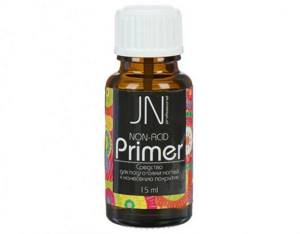
Acid-free nail primer, odorless. The manufacturer states in the description that the product provides reliable adhesion of the natural nail to gel polish or acrylic (can be used with both). Contains three ingredients, including alcohol. A thin, comfortable brush with medium-length bristles.
Suitable for both home and professional use. Can be used even on sensitive nails - does not dry out the skin.
Advantages and disadvantages
can be used with both gel and acrylic, no chemical smell
alcohol in the composition (can dry out the cuticle if you accidentally touch it)
TNL Professional
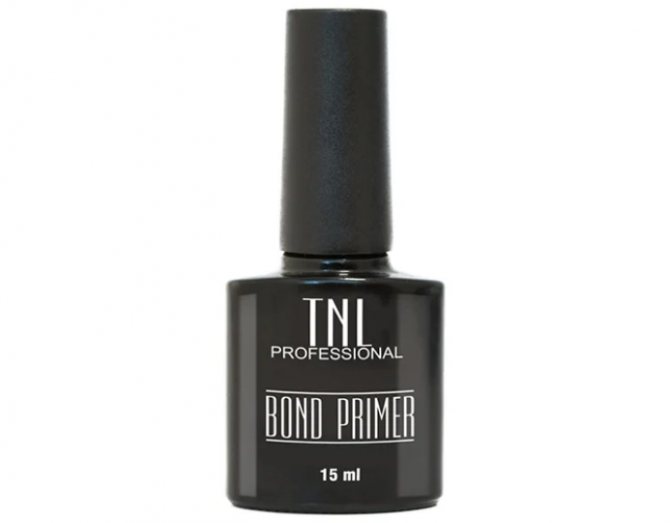
Acid-free primer-bond, suitable for professionals and beginners in manicure. Can be applied under gel polish or used for acrylic or gel nail extensions. Those who have already used this primer note that the coating lasts for a really long time - 4-5 weeks without chipping, cracking or peeling.
The primer has a strong chemical smell, but it dissipates quickly.
Advantages and disadvantages
can be used both before coating and before extensions, suitable for professionals and beginners
pungent odor
show more
Olystyle
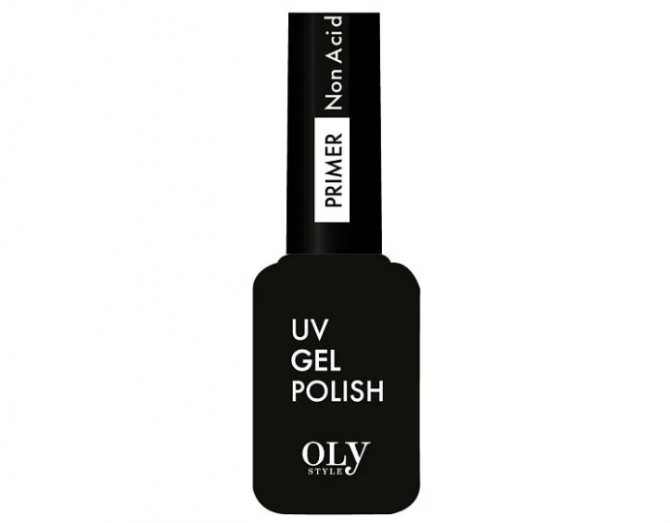
The brand's primer also promises perfect nail adhesion to gel polish or acrylic - be it a regular coating or extensions. The primer seems to glue the nail to the material without damaging the nail plate and acts as a protective layer. The product does not change the color of gel polish.
It has an oily texture and a pungent odor. The manufacturer promises both the durability of the coating and ease of removal.
Advantages and disadvantages
works as a protective layer, the coating lasts a long time
pungent odor, oily structure (some craftsmen find it inconvenient to work)
show more
UNO
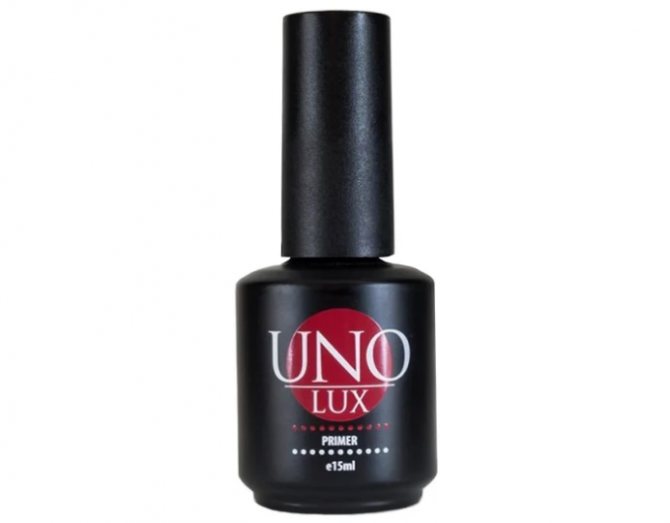
Professional primer, not suitable for home use, it is quite expensive. But manicurists are happy to work with him. This primer provides excellent nail “adhesion” to gel polish, extension gel, acrylic and even simple polish.
In other words, the primer works in all systems. Suitable for weak, thin, flaky nails.
Advantages and disadvantages
excellent adhesion, works in all systems, suitable for weak nails
acrid smell
Irisk Professional
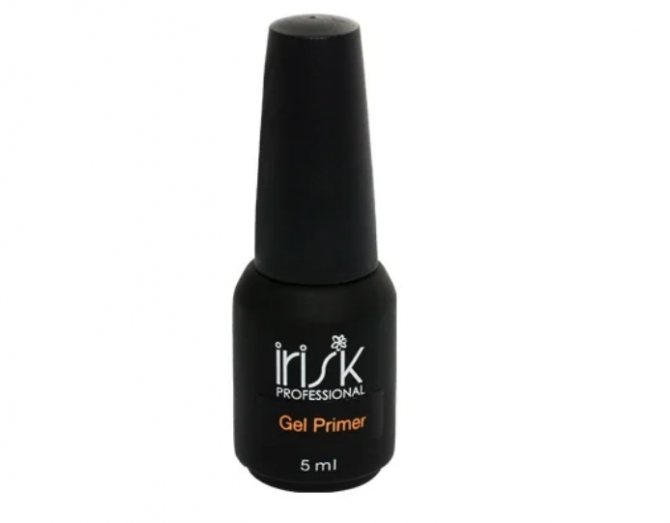
The primer, despite its affordable price, is considered a professional product. Irisk Professional Gel Primer, as noted by . A manicure with this primer can last as long as possible.
The craftsmen noticed that the product is easy to use - it has a comfortable brush and dries quickly in the air. But there are also complaints: they say the bottle does not close hermetically. Small volume - only 5 ml.
Advantages and disadvantages
dries quickly, creates good protection for nails
small volume, the bottle does not close tightly
Bagheera Nails
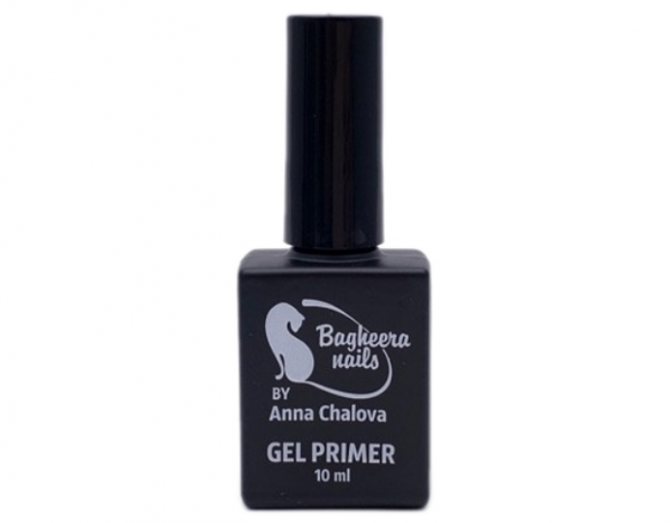
Acid-free primer ensures strong adhesion of the nail to the coating. However, many note that it takes a very long time to dry - competitors do it in 15-30 seconds, but Bagheera Nails need to dry for a whole minute. However, its adhesion is excellent, the color of the varnish does not distort or change, and there are no peelings.
The manufacturer notes that the primer works best with other products from this brand. It has a good consistency - not runny and not thick. The bottle contains a small brush that does not leave any lint.
Customers noted that the product has a pungent alcohol smell - this is a big minus. After all, the primer takes a long time to dry, and it makes the eyes of sensitive people watery.
Advantages and disadvantages
comfortable brush, excellent grip, good nail protection
takes a long time to dry and has an alcohol smell

What is a primer for shellac used for?
A nail primer (what it is and why you need it is described above) makes shellac easy to apply, increases its durability and creates a beautiful appearance for your nails.
The use of a special fluid ensures the following:
- degreasing and disinfection of natural nails;
- easy drying;
- protection of the structure of the natural plate;
- increased adhesion.
For shellac, acid-free primers or bonds are most often used.
How to choose a nail primer
When choosing a primer for home use, you need to pay attention to the following characteristics of the product:
1. High level of acids in the primer. It is important to monitor the presence of methacrylic acid in the product. In large quantities it causes burning, redness and can damage the natural nail. Therefore, it is better to use acid primers only in a salon with an experienced technician.

Improper use of acid primers damages nail plates
2. It is better to opt for acid-free primers. In this case, the packaging of the product should be marked “non-acid”. An acid-free primer, penetrating into the layers of the nail plate, forms a sticky coating, due to which the material will adhere better and stronger to the natural nail.
What is the composition based on?
You can find out which primer the artist uses during the application process: the acidic product leaves a whitish tint. When it appears, it means that the product has completely dried, you can proceed to the next stage of extension. Acid-free leaves no residue and remains completely transparent after drying. In this case, the master focuses on wet areas - if there are none, then the prime material has dried out.
The acid-free primer is odorless, which cannot be said about its acidic counterpart: the pungent odor suggests the use of a mask.
The consistency of prime products is thin, gel-like, and often watery. Available in the same bottles as gel polish or small plastic vials. The containers are opaque, since light adversely affects the structure of the product and shortens the shelf life.
The acid-free drug contains 3 main components:
- Ethyl acetate;
- 2-hydroxyethyl matacrylate;
- Methacrylic acid.
The latter substance is also contained here, but in small quantities, which does not pose any threat to brittle, peeling nails. First of all, these substances contribute to a strong “adhesion” of the gel polish to the keratin layer.
Attention! Sometimes using primers for manicure causes discomfort: tingling, tightness. But these phenomena are fleeting and do not affect the final result.
How to use nail primer
In order to get the expected result, the primer must be applied according to a special scheme, following the exact sequence:
- Perform a standard hygienic manicure.
- Give the nail plate a beautiful desired shape.
- Using a special buff, orange stick or pumice, carefully remove the cuticle.
- Correct the glossy surface of a natural nail with a gentle nail file.
- Treat the surface with a dehydrator to remove stickiness and grease.
- After this, you can apply the primer by scooping up a small ball of product with a brush and spreading it evenly over the nail plate.

Nail primer degreases and cleans plates, gives stability and evenness to manicure. - Remove excess product with a cotton swab dipped in running water.
- It is better to apply the product in a thin layer, otherwise the possibility of opening the scales on the nail will worsen.
- Wait a minute until the product is completely dry. Often the product simply dries in air; in some cases it requires drying in a UV lamp. In this case, there will be a special mark on the package.
- Apply varnish, gel or top at your discretion.
Don't miss the most popular article in the section: How to extend nails with gel polish. Nail extension instructions for beginners. Photo.
How to apply gel polish primer
A nail primer (you can learn what it is online yourself or consult a nail technician) is an additional fastener between an artificial and natural nail. Thanks to its high adhesion, the primer reliably and firmly holds the gel along the edges of the nail and at the ends (at the most vulnerable places).
The technology for applying primer to gel polish consists of the following points:
- Perform a hygienic manicure.
- Give your nails the desired shape.
- Push back the cuticle with a wooden stick.
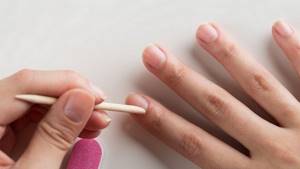
- Remove the glossy layer from a natural nail using a 220 grit buff.
- Be sure to degrease the nail using a dehydrator. This will help remove dust, grease, and excess moisture from the surface of the nail.
- Apply primer to the entire nail plate.
- After using base, varnish, gel.
The primer dries almost instantly, compared to analog gel products. The primer manufacturer eliminated the need to dry the coating under a UV lamp. If necessary, a special mark is made on the packaging. Therefore, before you start using, you must carefully study the instructions.
Primer, bonder, bond - what's the difference?
When choosing a primer, you need to keep in mind that different brands have different names. For example, Nail Club calls it Bond Primer, and InGarden calls it Bonder.
Acid-free primer Bond Primer Nail Club 18 ml
Bonder Bonder InGarden 11 ml
Why did it happen so? Due to the changes that occurred with the primer as the nail industry developed. At the very beginning, manufacturers introduced a gel product to prepare the nail plate for applying a base. This primer had a dense texture and required drying in a lamp. After a while, the product was made liquid so that it would not add extra thickness to the artificial turf, and it was called “bond.” But many manufacturers retained the previous name - “primer”. Therefore, now you can find primer, bond, bonder, as well as soft bond and ultra-bond in stores.
It so happens that manufacturers produce the same product under different names. Of course, this causes confusion and complicates the choice. The easiest way to avoid making mistakes when purchasing this product is to carefully study the label. If the bonder or primer says “acid-free” or “no acid”, this is the same “double-sided tape” that will improve the adhesion between the nail and the artificial turf.

How to use an acid-free tack primer
After application to the nail surface, many products leave a sticky layer, due to which improved adhesion is formed. They hold the extension product securely and firmly.
But, experienced professionals note that, in comparison with analogue preparations, these products take a little longer to dry. Therefore, they must be applied in a thin layer to ensure faster drying.
There is no need to try to speed up drying (by blowing on your nails), otherwise air bubbles may form. To do this, you need to take a small amount of product onto the brush. If after a minute after drying the surface is still wet, blot it with a dry cloth.
There is no need to dry acid-free primers under a special lamp, but many manufacturers systematically introduce new products, so it is better to carefully study the instructions and test for an allergic reaction before using the substance. It is accepted that some groups of acid-free primers require drying under a lamp.
Step by step application
How to apply the primer is indicated on the packaging of the product, but nail experts use their own secrets and tricks in their work. The following stages are distinguished:
- Shaping nails and treating cuticles.
- The surface of the nail plate is made rough and matte using a 220 grit buff. Avoid removing too thick a layer to avoid damaging your nail. Get rid of any remaining dust by carefully brushing your nails with a hard brush.
- Application of primer. Apply the product onto the brush, carefully removing the excess on the edge of the bottle, and cover the nail with a thin layer, starting from the middle. Try not to touch the cuticle. Some manicurists advise leaving a drop of primer in the middle of the nail and waiting for it to spread, then spreading it over the nail in one motion. Before each application, clean the brush with a tissue to prevent the appearance of a thick layer.
- Wait for the product to dry from one to three minutes. Some primers require drying in a UV lamp, which is indicated on the product packaging.
- Application of base, decorative coating and top.
The best acid primers
Top acid primers:
- The most popular and popular brand is Vogue Nails , which, despite its composition, does not have a strong aroma . The primer is applied using the standard method onto a clean, grease-free plate. The product effectively holds the gel polish on the surface of the nails for a long time; corrections can be avoided for more than 30-40 days. But, at the same time, it is worth knowing that Vogue Nails is quite aggressive; after prolonged use, minor damage to the nail plate may occur.
- The affordable NeoNail product is highly effective and strong . Primer "NeoNail" can be purchased for only 250-300 rubles; it prevents peeling and does not injure the nail.
- Inexpensive primer "LianaiL" You can buy it for independent use for only 300 rubles. Numerous reviews confirm high efficiency, durability, and the material does not chip or crack when used.
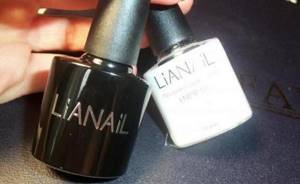
- A highly effective primer mixture for nails will cost customers only 400 rubles. The primer effectively removes excess moisture, degreases and disinfects the nail. One of the most ideal options.
- Primer "PNB" is an inexpensive but effective product with high performance. The cost is approximately 250-300 rubles. The downsides are the inconvenient bottle and brush, as well as a very strong smell.
The most reliable primer companies
Every major manufacturer of gel polishes has primers on sale. However, not all of them have quality that matches the price. Based on reviews, we chose the most worthy companies:
Kodi.
The American manufacturer has long established itself in the Russian market. Kodi's gel polishes and primers are also of high quality. The range includes acidic and acid-free products. In terms of price-quality ratio, this is one of the best options for craftsmen and home use.
TNL.
Primers from this Korean brand have received high ratings from users. Manicurists especially praise the acid-free product. It dries well, moisturizes nails, and protects the gel coating from chips and cracks.
Dance Legend.
The Russian brand did not disappoint its fans with the quality of its primers. The products from this manufacturer have a gentle composition, good protective properties and economical consumption.
The Best Acid-Free Primers
The most popular acid-free primers:
- Popular acid-free primer "Bluesky". The primer effectively holds gel and acrylic material on the nail plate. When using, drying under a lamp is not required. Apply the product in a minimal layer to allow the product to dry better. If after a minute it has not dried, blot the nail plate with a dry cloth. Before treating your nails with decorative material, you should wait until the primer has completely dried. The Bluesky structure has an oil base and does not have a strong aroma. Mainly used before applying base.
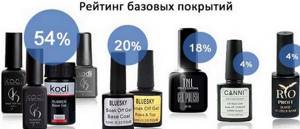
- For thorough preparation for a manicure, Luxio is suitable . The primer differs from analogues in its high characteristics, but costs almost 1,300 rubles.
- American-made Cuccio is an effective nail primer . The advantage is an affordable pricing policy, the primer costs 600-650 rubles.
- The liquid from China is quite cheap - only 200-220 rubles. Despite the low price, the product is highly effective, can degrease, disinfect, and effectively adheres to nail surfaces. Disadvantages - an inconvenient brush for application, as well as a strong unpleasant aroma.
- Acid-free primer "Kodi" is at the top of the ranking of top products . Buyers speak well of the composition, reliability, fairly affordable cost, and convenient method of application. The product line of this brand also includes acid primers.
Best pre-primers
It is often recommended to use a prep primer before using a classic primer. The advantage of the drug is the fact that there is no negative effect on the structure of the nail plate. Not many people know what a nail primer of the “Bond” variety is. This product is recommended to be used only before the extension material is applied.
The most popular pre-primers include the following types:
- Hong Kong remedy is a universal primer that is used as a primer and can be used as a base coat. The cost of the product is quite affordable - 500 rubles.
- Cheap nail product "inGarden" , which will cost customers only 230 rubles, has fairly high adhesive properties and effectively degreases the surface. The advantage of the product is its safety for the nail plate and the skin around it.
- High-quality YOKO primer has good adhesion properties and demonstrates high-quality adhesion. The price of the product is about 300 rubles.
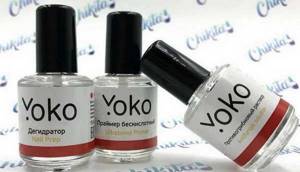
- EzFlow degreasing liquid does not contain dyes or flavors , therefore it does not cause irritation or an allergic reaction. The primer dries almost instantly, but the cost of the product is quite high - 1000 rubles.
- The “CND” primer is rightfully considered one of the highest quality , but has a high cost - 1150 rubles. It is great for use on weak, thin nails and will provide durable and high-quality extensions. Thanks to the unique formula of the composition, the primer is hypoallergenic and does not cause burning or burning.
Advantages and disadvantages
We can talk endlessly about the advantages and necessity of using primers. Highlighting the main points, they note the ability to degrease the nail, dry the top layer without affecting the structure of the nail plate.
The primer gently disinfects the surface, preventing the development of fungi and pathogenic microflora directly under the decorative coating. Thus, the product preserves the health of the natural nail.
Excessive use of artificial manicure coatings leads to delamination, deformation and yellowing of the nail plate. The primer effectively combats undesirable consequences by protecting the nail surface from direct contact with chemicals.
Why do you need a primer? What are their differences / Gel polish coating without peeling
Concerns in use are associated with methacrylic acid, which is present in diluted form. If you work carelessly and in case of contact with the cuticle or skin, you should immediately wash your hands with running water and soap to avoid burns.
Many people are interested in what to replace the primer with. There are no other effective home remedies for nail extensions. To apply regular varnish, achieve a similar effect on the nail by washing your hands with laundry soap, wiping with vinegar, lemon juice, nail polish remover or alcohol, followed by thoroughly drying the nails.
How to distinguish a nail primer from a base?
The problem of how to distinguish a primer from a nail base worries mainly newcomers to the nail industry. This question may arise due to the fact that the functions of these two products are quite similar; they provide adhesion to the surface of the natural nail and the applied substance. It is worth understanding that the primer is not a separate layer.
This is just an impregnation liquid that does not dry in a lamp.
The base consists of a three-component coating layer, a sticky top layer, gloss and a layer that cures under the rays of a UV lamp.
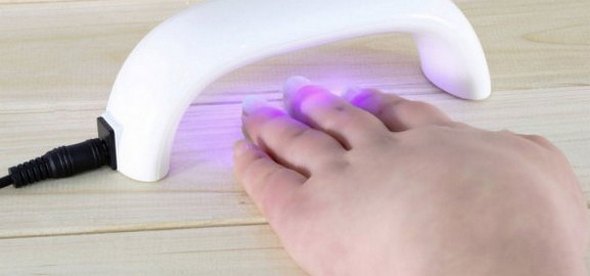
A primer must be used, and a nail base is recommended to be used only when you plan to apply single-phase gel polishes for coating. Otherwise, the result of the extension may not be so durable.
Frequently asked questions or FAQ for beginners
What can you replace nail primer with?
A sufficiently acidic base that does not require a bonder. Nails should be prepared for coating and degreased with Nail Prep. Use a buff or file to lift the scales of the dorsal layer, then apply a dehydrator (ph-bond, dry nail), and let it dry. Then apply a rubbing layer of a sufficiently acidic base and polymerize it in a UV lamp. Next, you can strengthen it using the leveling technique and cover the nails with color and topcoat.
Is it possible to use a primer from one company and a base from another?
It is possible, but first carefully study their adhesive properties. It is important to consider their acidity. If the base turns out to be more acidic than the bonder, then applying such a bonder will worsen the adhesion of the base to the nail plate. For acid bases, a degreaser and a dehydrator are sufficient. But under completely acid-free bases, you can add a layer of acid-free primer, since it will still be a little more acidic and this will improve adhesion.
Which is better: acid-free primer?
Acid-free: sufficiently improves adhesion, hypoallergenic, no risk of chemical burns, minimally dries out nails.
Acidic: maximizes adhesion, allergenic, there is a risk of burns and dermatitis, very drying nails.
For regular use, it is better to choose an acid-free one, and use an acidic one only in extreme cases.
Dehydrator, bonder, bond, primer - what's the difference?
Unfortunately, material manufacturers have never agreed to associate one specific name with a specific function. Everyone names materials differently. Therefore, from different manufacturers, both the primer and the bonder may function as both a dehydrator and “double-sided tape.” The masters agreed as follows: a primer or bonder is a product that leaves a sticky layer after drying. Dehydrator, ph-bond - something that pulls excess moisture out of the nail . When purchasing, it is important to read what the manufacturer promises as a result of using this product, and if it is “degreasing, dehydrating, changing the pH,” then this is a dehydrator. If it says “leaves a sticky layer, works like double-sided tape,” then this is a bonder.
What to apply first - bonder or primer?
See previous question. If the function of the product is aimed at degreasing and dehydration, then it is applied first. The next step is to apply a sticky product.
What is the difference between primer and gel polish base?
The primer or bonder is absorbed into the nail plate and dries in the air, serves as a primer, and is applied locally. The base is applied to the entire nail, polymerized in a UV lamp, and can be used to smooth, strengthen and extend nails. They are not interchangeable, but if the base is acidic, then a bonder is not needed.
Primer replacement
If it is not possible to use a primer, its corresponding analogues are quite suitable:
- Less aggressive pre-primer or bond. This is a more gentle preparation that does not have a negative effect on the natural plate.
- If you don’t have special products on hand, you can use simple cologne or perfume, which will also effectively degrease your nails.
- A standard liquid or acetone will help remove dust and grease from the natural nail plate.
- Food vinegar will cope with degreasing and disinfection before applying extension material.
- Boric acid is a worthy alternative to primer.
It is important to know! Products containing oils should not be used as a replacement for primer.
In order for the extension to work out as intended, you must strictly follow the advice and consult with an experienced nail technician in advance about what a nail primer is and how to use it correctly. Experienced experts recommend choosing a primer that does not require special drying under a lamp. This will help reduce labor intensity and work time.
Article design: Olga Pankevich

